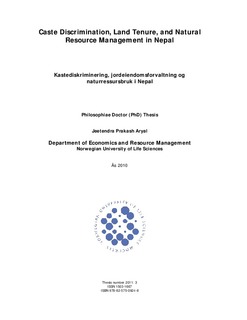| dc.contributor.advisor | Holden, Stein T. | |
| dc.contributor.author | Aryal, Jeetendra Prakash | |
| dc.coverage.spatial | Nepal | nb_NO |
| dc.date.accessioned | 2017-02-27T10:19:46Z | |
| dc.date.available | 2017-02-27T10:19:46Z | |
| dc.date.issued | 2011 | |
| dc.identifier.isbn | 978-82-575-0924-8 | |
| dc.identifier.issn | 1503-1667 | |
| dc.identifier.uri | http://hdl.handle.net/11250/2432127 | |
| dc.description.abstract | The dissertation investigates the issues related to land tenancy transactions, land productivity and land related investment with a due focus on caste discrimination in the Nepalese rural society. This study also explores the potential interlinkages between land and livestock rental markets in rural Nepal. This dissertation comprises of an introduction and four independent papers. All the papers were based on the data collected in 2003 from the Western region of Nepal. Paper I assesses the caste-related land productivity differential in rural Nepal and its possible explanations. The analysis showed that low-caste households have higher land productivity as compared to high-caste households both on owner operated plots and rented in plots. The major reason behind this can be the concentration of their labor in small farms as they have lower access to regular off-farm income due to caste discrimination, low education/skills, lack of family networks and stronger subsistence constraints. Paper II examines jointly the existence of Marshallian inefficiency in sharecropping, allocative inefficiency of land tenancy transactions and an inverse farm size-productivity relationship and how these phenomena are associated with caste discrimination in Nepal. The analysis revealed that inefficiency of land tenancy transactions and caste discrimination are the major causes of inverse relationship. Paper III examined the factors that drive livestock rental market participation of the farm households in rural Nepal. Results show that differences in resource endowments and in the access to factor markets between low-caste and high-caste households as the important reasons for the emergence of the livestock rental market. Paper IV assesses if the investment and intensity of production differ between high-caste and low-caste households. This paper relates caste issue with poverty as low-caste households are poor both in terms of income and land asset. The paper analyzes the differences in short-term investments in terms of fertilizer use and manure use as well as more long-term investments in terms of terrace maintenance expenditure and intensity of cropping. Results show that there are differences in the likelihood to use manure and amount of fertilizer used between highcaste and low-caste households. Access to off-farm employment is found to have significant negative effect on land conservation investment. | nb_NO |
| dc.language.iso | eng | nb_NO |
| dc.publisher | Norwegian University of Life Sciences, Ås | nb_NO |
| dc.relation.ispartofseries | PhD Thesis;2011:03 | |
| dc.rights | Attribution-NonCommercial-NoDerivatives 4.0 Internasjonal | * |
| dc.rights.uri | http://creativecommons.org/licenses/by-nc-nd/4.0/deed.no | * |
| dc.title | Caste discrimination, land tenure, and natural resource management in Nepal | nb_NO |
| dc.title.alternative | Kastediskriminering, jordeiendomsforvaltning og naturressursbruk i Nepal | nb_NO |
| dc.type | Doctoral thesis | nb_NO |
| dc.subject.nsi | VDP::Social science: 200::Economics: 210::Economics: 212 | nb_NO |
| dc.source.pagenumber | 1 b. (flere pag.) | nb_NO |

